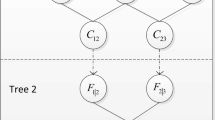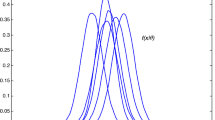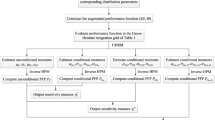Abstract
By the average absolute difference between the unconditional failure probability and the conditional one on fixing an input at its realization, the failure-probability-based-sensitivity (FP-S) is defined to quantify the effect of the fixed input on the failure probability, which provides important information for reliability-based design optimization of the structure. Among the estimation methods for FP-S, the Bayes theorem-based methods are competitive, but the conditional probability density function (PDF) should be estimated in this type method. To alleviate the computational complexity of estimating conditional PDF, a novel FP-S estimation method is proposed by use of the conditional probability theorem. In the proposed method, the conditional failure probability on fixing the input at its realization is approximated by the conditional failure probability on fixing the input in a small interval, in which the conditional probability theorem of the random event can be used to transform FP-S as estimations of a series of probabilities, and they can be simultaneously completed by a numerical simulation for estimating the unconditional failure probability. For ensuring the precision of the approximation introduced by replacing the realization with the small interval, a selection strategy for the small interval is proposed. Comparing with the competitive Bayes theorem-based estimation for FP-S, the proposed method replaces the conditional PDF estimation with the conditional probability estimation, which greatly reduces the computational complexity and improves the accuracy of the FP-S estimation. By combining with the adaptive kriging surrogate model, the efficiency of the proposed method can be drastically improved, and the presented examples demonstrate the efficiency and accuracy of the proposed method.











Similar content being viewed by others
References
Au SK (2005) Reliability-based design sensitivity by efficient simulation. Comput Struct 83(14):1048–1061
Bdour T, Guiffaut C (2016) Use of adaptive Kriging metamodeling in reliability analysis of radiated susceptibility in coaxial shielded cables. IEEE Trans Electromagn Compat 58(1):95–102
Borgonovo E, Plischke E (2016) Sensitivity analysis: a review of recent advances. Eur J Oper Res 3(1):869–887
Ching J, Hsieh YH (2007) Local estimation of failure probability function and its confidence interval with maximum entropy principle. Probabilistic Eng Mech 1:39–49
Cui LJ, Lu ZZ, Zhao XP (2010) Moment-independent importance measure of basic random variable and its probability density evolution solution. Sci China Technol Sci 53(4):1138–1145
Echard B, Cayton N, Lemaire M (2011) AK-MCS: an active learning reliability method combining Kriging and Monte Carlo Simulation. Struct Saf 33(2):145–154
Fu J, Liu Q, Liufu K, Deng YC (2019) Design of bionic-bamboo thin-walled structures for energy absorption. Thin-Walled Struct 135:400–413
Grooteman F (2008) Adaptive radial-based importance sampling method for structural reliability. Struct Saf 30:533–542
Harbitz A (1986) An efficient sampling method for probability of failure calculation, structural safety. 3:109–115
Hu J, Zhou Q, Jiang P et al (2017) An adaptive sampling method for variable-fidelity surrogate models using improved hierarchical Kriging. Eng Optim:1–19
Jensen HA (2005) Structural optimization of linear dynamical systems under stochastic excitation: A moving reliability data-based approach. Comput Methods Appl Mech Eng 194:1757–1778
Jones DR, Schonlau M, Welch WJ (1998) Efficient global optimization of expensive black-box functions. J Glob Optim 13:445–492
Lemaître P, Sergienko E, Arnaud A et al (2015) Density modification-based reliability sensitivity analysis. J Stat Comput Simul 85(6):1200–1223
Li J, Chen JB (2007) The number theoretical method in response analysis of nonlinear stochastic structures. Comput Mech 39(6):693–708
Li LY, Lu ZZ (2017) Variance-based sensitivity analysis for models with correlated inputs and its state dependent parameter solution. Struct Multidiscip Optim 56(4):919–937
Li LY, Lu ZZ, Feng J (2012) Moment-independent importance measure of basic random variable and its state dependent parameter solution. Struct Saf 38:40–47
Liu HT, Cai JF, Ong YS (2017) An adaptive sampling approach for Kriging metamodeling by maximizing expected prediction error. Comput Chem Eng 106(2):171–182
Low BK, Zhang J, Tang WH (2011) Efficient system reliability analysis illustrated for a retaining wall and a soil slope. Comput Geotech 38(2):196–204
Melchers RE (1989) Importance sampling in structural system, structural safety. 6:3–10
Perrin G, Defaux G (2019) Efficient evaluation of reliability-oriented sensitivity indices. J Sci Comput 79(3):1433–1455
Saltelli A (2002) Sensitivity analysis for importance assessment. Risk Anal 22(3):579–590
Saltelli A, Sobol IM (1995) Sensitivity analysis for nonlinear mathematical models: numerical experience. Inst Math Model 7(11):16–28
Saltelli A, Ratto M, Andres T et al (2008) Variance-based methods [M]// global sensitivity analysis. The Primer. Wiley
Sobol IM (2001) Global sensitivity indices for nonlinear mathematical models and their Monte Carlo estimates. Math Comput Simul 55:271–280
Sobol IM (2003) Theorems and examples on high dimensional model representation. Reliab Eng Syst Saf 79:187–193
Wang P, Lu ZZ, Xiao SN (2017) A generalized separation for the variance contributions of input variables and their distribution parameters. Appl Math Model 47:381–399
Wang YP, Xiao SN, Lu ZZ (2018) A new efficient simulation method based on Bayes’ theorem and importance sampling Markov chain simulation to estimate the failure-probability-based global sensitivity measure. Aerosp Sci Technol 79:364–372
Wang YP, Xiao SN, Lu ZZ (2019) An efficient method based on Bayes’ theorem to estimate the failure-probability-based global sensitivity measure. Mech Syst Signal Process 115:607–620
Wei PF, Lu ZZ, Hao WR (2012) Efficient sampling methods for global reliability sensitivity analysis. Comput Phys Commun 183(8):1728–1743
Wei PF, Lu ZZ, Song JW (2013) A new variance-based global sensitivity analysis technique. Comput Phys Commun 184:2540–2551
Yun WY, Lu ZZ, Jiang X (2016) An efficient method for failure probability-based moment-independent sensitivity analysis. Chin J Theor Appl Mech 48(4):1004–1012
Yun WY, Lu ZZ, Jiang X (2018a) An efficient global reliability sensitivity analysis algorithm based on classification of model output and subset simulation. Struct Saf 74:49–57
Yun WY, Lu ZZ, Jiang X (2018b) A modified importance sampling method for structural reliability and its global reliability sensitivity analysis. Struct Multidiscip Optim 57(4):1625–1641
Yun WY, Lu ZZ, Jiang X (2019) An efficient method for moment-independent global sensitivity analysis by dimensional reduction technique and principle of maximum entropy. Reliab Eng Syst Saf 187:174–182
Zhang H, Han C (2010) A new quasi-Monte Carlo filtering algorithm based on number theoretical method, IEEE International Conference on Information and Automation. ICIA2010
Zheng PJ, Wang CM, Zong ZH et al (2017) A new active learning method based on the learning function U of the AK-MCS reliability analysis method. Eng Struct 148:185–194
Acknowledgment
Authors gratefully acknowledge the support of the National Natural Science Foundation of China (Grant No. NSFC 51775439) and the National Science and Technology Major Project (2017-IV-0009-0046).
Replication of results
The original codes of examples in the Section 4 including 4 folders are available in the Supplementary materials, i.e., Example1.m, Example2.m, Example3.m and Example4.m. The results can be replicated by running codes directly.
Author information
Authors and Affiliations
Corresponding author
Ethics declarations
Conflict of interest
The authors declare that they have no conflict of interest.
Additional information
Responsible Editor: Christian Gogu
Publisher’s note
Springer Nature remains neutral with regard to jurisdictional claims in published maps and institutional affiliations.
Appendix
Appendix
To construct a Kriging surrogate model, the output of the model Y = g(X) can be considered as a realization of stochastic process represented in Refs. (Jones et al. 1998; Bdour and Guiffaut 2016)
where β0 is the mean value and Z(X) represents a stationary Gaussian process with zero mean and a covariance between two samples x(i) and x(j), the covariance is defined by.
here, σ2 is the process variance of Z(⋅), R is the spatial correlation function, which is only dependent on the spatial distance between x(i) and x(j). In this paper, the widely used Gaussian correlation is employed.
Therefore, for the arbitrary sample x, the Kriging model gK(x) is a Gaussian random process, i.e., \( {g}_K(x)\sim N\left({\mu}_{g_K}(x),{\sigma}_{g_K}^2(x)\right) \), where \( {\mu}_{g_K}(x) \) and \( {\sigma}_{g_K}^2(x) \) are the Kriging prediction mean and variance respectively. More details can be obtained in Refs. (Jones et al. 1998; Bdour and Guiffaut 2016).
In order to construct a convergent adaptive Kriging (AK) model for the output of model and to identify the input samples falling into the failure domain, a sample pool and an active learning strategy are required. Firstly, a sample pool of input variables is built asS = {x1, x2, ..., xN}. Subsequently, N0 initial samples are selected to establish the initial Kriging model. Then, an active learning function is employed to select new training sample with the most contribution to the prediction quality to refine the initial Kriging model. For the failure problem, a widely used learning function, named as U-learning function (Echard et al. 2011), is adopted and it is denoted as
The U-learning function implies a reliability index of misjudging the sign of g(x) by gK(x), i.e.,
where Φ(⋅) denotes the calculative distribution function of a standard normal variable. Thus, the new training sample can be found in the sample pool by
When U(x) = 2, it indicates that there is Φ(−2) = 0.0228 probability to misjudge the sign of g(x). Then the stop criterion of selecting the new training point in the sample pool S to update the current Kriging model is given as
Rights and permissions
About this article
Cite this article
He, L., Lu, Z. & Feng, K. A novel estimation method for failure-probability-based-sensitivity by conditional probability theorem. Struct Multidisc Optim 61, 1589–1602 (2020). https://doi.org/10.1007/s00158-019-02437-x
Received:
Revised:
Accepted:
Published:
Issue Date:
DOI: https://doi.org/10.1007/s00158-019-02437-x




